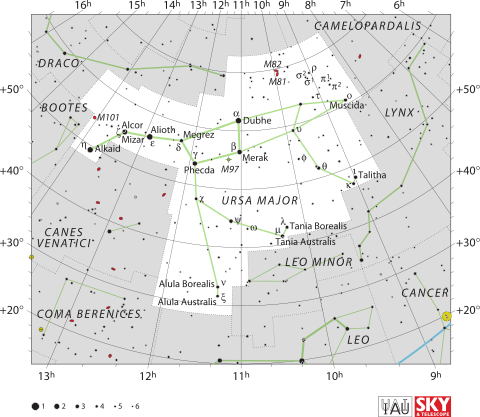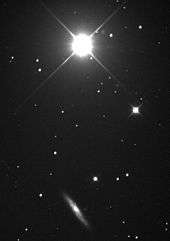Chi Ursae Majoris
Chi Ursae Majoris (χ Ursae Majoris, abbreviated Chi UMa, χ UMa), formally named Taiyangshou /ˌtaɪˌjæŋˈʃoʊ/,[9] is a star in the constellation of Ursa Major. It is approximately 246 light-years from the Sun.
 | |
| Observation data Epoch J2000.0 Equinox J2000.0 (ICRS) | |
|---|---|
| Constellation | Ursa Major |
| Right ascension | 11h 46m 3.01407s[1] |
| Declination | +47° 46′ 45.8626″[1] |
| Apparent magnitude (V) | 3.72[2] |
| Characteristics | |
| Spectral type | K0.5 IIIb[3] |
| U−B color index | +1.16[2] |
| B−V color index | +1.18[2] |
| Astrometry | |
| Radial velocity (Rv) | −9.02±0.20[2] km/s |
| Proper motion (μ) | RA: −138.29[1] mas/yr Dec.: 28.57[1] mas/yr |
| Parallax (π) | 17.76 ± 0.16[1] mas |
| Distance | 184 ± 2 ly (56.3 ± 0.5 pc) |
| Absolute magnitude (MV) | 0.10±0.020[4] |
| Details[2] | |
| Mass | 1.49[5] M☉ |
| Radius | 20.8±0.8[6] R☉ |
| Luminosity | 158 L☉ |
| Surface gravity (log g) | 2.2 cgs |
| Temperature | 4,416±9 K |
| Metallicity [Fe/H] | −0.44 dex |
| Rotational velocity (v sin i) | 2.3 km/s |
| Other designations | |
| Database references | |
| SIMBAD | data |
Nomenclature

χ Ursae Majoris (Latinised to Chi Ursae Majoris) is the star's Bayer designation.
It bore the traditional name Tai Yang Show, "the Sun Governor", from Chinese astronomy.[10] The name was possibly derived from the word 太陽守, Pinyin: Tàiyángshǒu, meaning Guard of the Sun, because this star is marking itself and standing alone in the Guard of the Sun asterism, Purple Forbidden enclosure (see : Chinese constellations). It also bore traditional names of Arabic origin: Alkafzah, Alkaphrah, and El Koprah.[7]
In 2016, the IAU organized a Working Group on Star Names (WGSN)[11] to catalog and standardize proper names for stars. The WGSN approved the name Taiyangshou for this star on 30 June 2017 and it is now so included in the List of IAU-approved Star Names.[9]
Properties
Chi Ursae Majoris is an evolved, orange hued K-type giant with an apparent magnitude of +3.69. This star has 20.8±0.8[6] times the radius of the Sun and 1.49 times the Sun's mass.[5]
The spiral galaxy in Ursa Major, NGC 3877 (= H I.201), type Sc, is best found from Chi Ursae Majoris, which is almost exactly 15 arcminutes north of the galaxy.
See also
References
- van Leeuwen, F. (2007), "Validation of the new Hipparcos reduction", Astronomy and Astrophysics, 474 (2): 653–664, arXiv:0708.1752, Bibcode:2007A&A...474..653V, doi:10.1051/0004-6361:20078357.
- Jennens, P. A.; Helfer, H. L. (September 1975), "A new photometric metal abundance and luminosity calibration for field G and K giants", Monthly Notices of the Royal Astronomical Society, 172: 667–679, Bibcode:1975MNRAS.172..667J, doi:10.1093/mnras/172.3.667.
- Keenan, Philip C.; McNeil, Raymond C. (1989), "The Perkins catalog of revised MK types for the cooler stars", Astrophysical Journal Supplement Series, 71: 245, Bibcode:1989ApJS...71..245K, doi:10.1086/191373.
- Park, Sunkyung; et al. (2013), "Wilson-Bappu Effect: Extended to Surface Gravity", The Astronomical Journal, 146 (4): 73, arXiv:1307.0592, Bibcode:2013AJ....146...73P, doi:10.1088/0004-6256/146/4/73.
- Luck, R. Earle (2015), "Abundances in the Local Region. I. G and K Giants", Astronomical Journal, 150 (3), 88, arXiv:1507.01466, Bibcode:2015AJ....150...88L, doi:10.1088/0004-6256/150/3/88.
- Nordgren, Tyler E.; et al. (December 1999), "Stellar Angular Diameters of Late-Type Giants and Supergiants Measured with the Navy Prototype Optical Interferometer", The Astronomical Journal, 118 (6): 3032–3038, Bibcode:1999AJ....118.3032N, doi:10.1086/301114.
- Bakich, Michael E. (1995), The Cambridge Guide to the Constellations, Cambridge University Press, pp. 112, 116, ISBN 0521449219
- "chi UMa". SIMBAD. Centre de données astronomiques de Strasbourg. Retrieved 2017-02-22.
- "Naming Stars". IAU.org. Retrieved 16 December 2017.
- Richard Hinckley Allen: Star Names — Their Lore and Meaning: Ursa Major
- "IAU Working Group on Star Names (WGSN)". Retrieved 22 May 2016.
External links
- Chi Ursae Majoris on WikiSky: DSS2, SDSS, GALEX, IRAS, Hydrogen α, X-Ray, Astrophoto, Sky Map, Articles and images